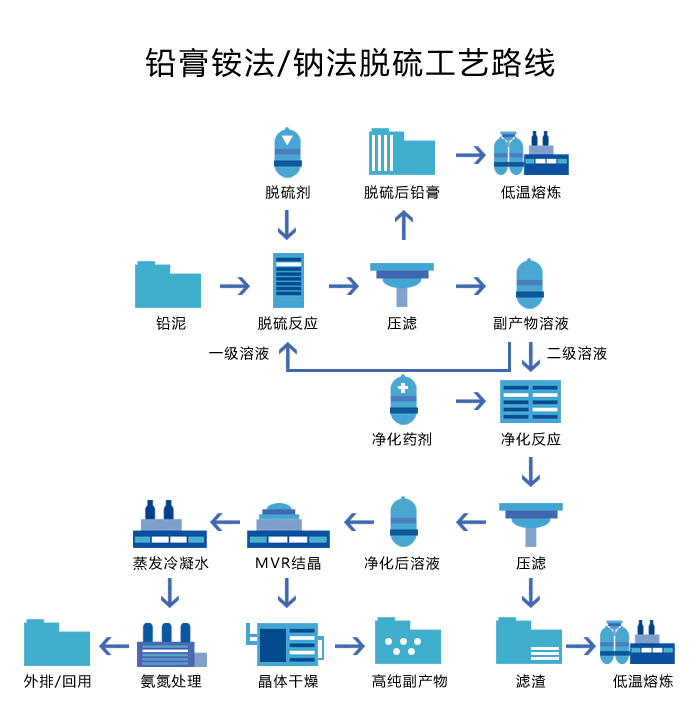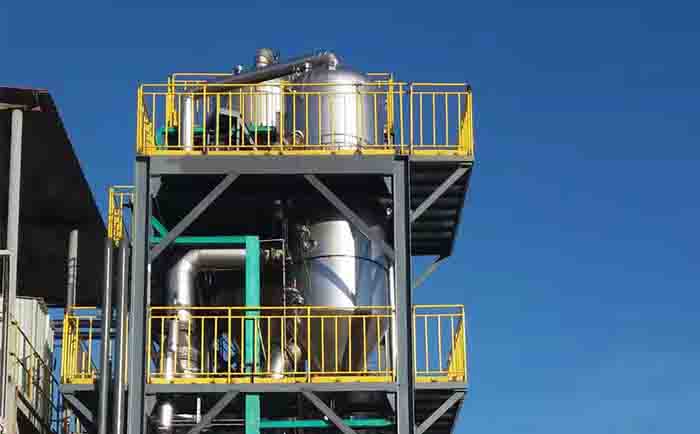The significance of desulfurization solution in lead-acid battery resource recovery system:
A large amount of acidic heavy metal industrial wastewater is generated during the manufacturing and production process of lead-acid batteries. If discharged without treatment, it will inevitably bring great harm to the environment and society. Lead and cadmium in wastewater are heavy metal elements and are a type of pollutant. If not recycled and treated, not only will large areas of land be needed for stacking or landfilling, but lead is also a toxic substance. Sulfuric acid has strong corrosiveness, and they will cause significant harm to the environment and soil, while also resulting in a large amount of resource waste. Therefore, effective pollution treatment must be carried out on waste lead-acid batteries.
Recycling technology for waste lead-acid batteries:
A technology for recycling recycled lead from waste lead-acid batteries and achieving comprehensive utilization of its components. Through automatic crushing and sorting of waste batteries, each component of the battery is treated to achieve the goal of recycling.
Process flow of waste lead-acid battery treatment:
The process flow includes crushing, sorting, and desulfurization of waste lead-acid batteries with lead paste (desulfurization and by-product recovery technology; oxygen enriched combustion technology, plastic granulation technology, carbon reduction smelting technology, refining and alloy configuration technology)
1. After desulfurization, the PbSO4 in the lead paste is converted into PbCO3, which can lower the smelting temperature by 300 ℃, achieve low-temperature smelting of lead paste, reduce energy consumption, and minimize the generation of lead dust;
2. To prevent or reduce the emission of SO2 pollutants into the atmosphere during the lead paste smelting process, reducing the burden of tail gas desulfurization on smelting units and making it more environmentally friendly;
3. The comprehensive recovery and utilization of S element in lead paste can be achieved, and high-purity by-products such as ammonium sulfate or sodium sulfate can be prepared, creating more economic value.

Lead paste desulfurization and conversion system for waste lead-acid batteries:
In the waste lead-acid battery resource recycling system, lead paste pre desulfurization refers to the chemical conversion of lead sulfate into lead carbonate. Desulfurizers can be soluble carbonates (sodium carbonate, ammonium carbonate, NH bicarbonate, etc.) and alkaline solutions (sodium hydroxide, NH water, etc.). Considering economy and operability, sodium carbonate and ammonium bicarbonate are more suitable. Compared with traditional processes, the desulfurization process can reduce the consumption of iron filings and cosolvents, lower the temperature, and save energy.
Waste lead-acid battery lead paste desulfurization by-product recycling system:
The desulfurization solution and collected waste acid electrolyte are pumped into the by-product recovery system, and after neutralization, evaporation, and crystallization techniques, sodium sulfate products are generated.
Process flow of waste lead-acid battery lead paste desulfurization by-product recovery system:
All waste electrolyte and dilute sulfuric acid are collected and transferred to the sulfate by-product generation system for complete conversion into sodium sulfate products; The liquid separated from the crushing and sorting equipment and the waste acid collected from other locations are composed of acidic liquid and electrolyte. They are collected in the waste liquid tank and pumped into the filter machine together with the desulfurization mother liquor to remove the solid components. After that, they enter the by-product recovery system and undergo neutralization, evaporation, and crystallization technologies to produce high-quality sodium sulfate products. This product can be used as an additive for detergents, papermaking, and glass products.
Advantages of ammonium salt desulfurization technology for waste lead-acid batteries using lead paste:
1. The sulfur content of the material is stable and the reaction efficiency is high; The material only contains 0.6% sulfur.
2. Expansion suppression system: increased production capacity by 4 times; Purification system: heavy metal impurity content below 5 ppm;
3. Each regenerated lead can save 1.36 tons of standard coal, reduce solid waste emissions by 98.7 tons, and reduce sulfur dioxide emissions by 0.66 tons,
4. Secondary utilization of desulfurization mother liquor significantly reduces energy consumption;
5. The resource recycling and utilization rate is high, the equipment requirements are low, and the by-products have a good market.

 English
English  Español
Español  Português
Português  русский
русский  français
français  日本語
日本語  Deutsch
Deutsch  Tiếng Việt
Tiếng Việt  Italiano
Italiano  Nederlands
Nederlands  ไทย
ไทย  Polski
Polski  한국어
한국어  Svenska
Svenska  Malay
Malay  বাংলা
বাংলা  हिन्दी
हिन्दी  Pilipino
Pilipino  Türk
Türk  عربى
عربى  Indonesia
Indonesia  norsk
norsk  čeština
čeština  Українська
Українська  Javanese
Javanese  فارسی
فارسی  తెలుగు
తెలుగు  Burmese
Burmese  български
български  Latine
Latine  Azərbaycan
Azərbaycan  Српски
Српски  Esperanto
Esperanto  Afrikaans
Afrikaans  Català
Català  Cymraeg
Cymraeg  Беларус
Беларус  Hrvatski
Hrvatski  Kreyòl ayisyen
Kreyòl ayisyen  Shqiptar
Shqiptar  Bosanski
Bosanski  Кыргыз тили
Кыргыз тили  ಕನ್ನಡ
ಕನ್ನಡ  IsiXhosa
IsiXhosa  Chichewa
Chichewa  Somali
Somali  O'zbek
O'zbek  հայերեն
հայերեն  Sundanese
Sundanese  Malagasy
Malagasy 







